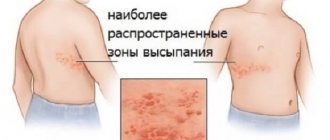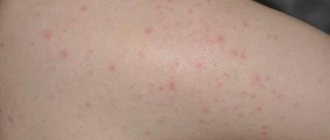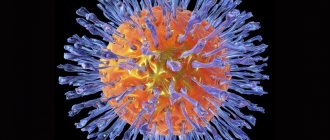Blisters on the back: what are they?
Blisters differ from other rashes in several ways:
- rise above the skin;
- have clear boundaries;
- are a manifestation of skin edema.
The appearance of watery tubercles is usually immediate (usually after exposure to an irritant). When the irritant is removed, the blisters disappear just as quickly. Bumps on the skin occur as a result of swelling and cause itching.
Some dermatologists call blisters exactly the kind of formations that we described above. They classify blisters with fluid after swelling or abrasions as other types of rashes. However, most doctors combine all these concepts into one type.
Depending on the clinical picture, they are usually divided into 3 types:
Benign
(atheroma, hemangioma, lymphangioma, lipoma, papilloma, mole, nevus, fibroma, neurofibroma)
They do not pose a threat to human life, but if poorly placed or large in size, they can cause disturbances in the functioning of other systems and/or organs of our body. Under external influences they can sometimes transform into malignant neoplasms.
Malignant
(basal cell carcinoma, melanoma, sarcoma, liposarcoma)
They grow quickly and aggressively, penetrating into surrounding tissues and organs, often with the formation of metastases. The prognosis of such diseases is often unfavorable, given the difficulty of curing them and the tendency for frequent relapses, and in some cases, active metastasis leads to death if vital organs are irreversibly damaged.
Borderline or precancerous skin conditions
(senile keratoma, xeroderma pigmentosum, cutaneous horn, Bowen's dermatosis)
Formations, the tissues of which, under the influence of hereditary or current causes, have changed, having the potential to degenerate into malignant tumors.
Why do blisters appear on the back of an adult?
Often small blisters on the back and stomach can arise for the most unexpected reason, in which a person does not see the danger. In most cases, the problem is caused by ordinary household factors. We list the most common causes of the disease.
- Eating problems
Skin diseases are often the result of poor nutrition. If a person abuses sweets, alcohol and regularly includes fatty, fried and other unhealthy foods in his diet, then the body can react with the appearance of acne, pimples and - in severe cases - blisters.
- Hormonal imbalances
With hormonal imbalances, regular acne more often appears on the back, but in some cases blisters and blisters may appear.
- Inappropriate cosmetics
Cosmetics (cream, shower gel) can also cause rashes on the back. During the period of exacerbation and subsequently, for the purpose of prevention, it is better to switch to neutral, hypoallergenic cosmetics.
- Insufficient hygiene
If your back skin is rarely cleansed, the pores become clogged, leading to blemishes, rashes, and sometimes blisters.
- Burn
People often notice that blisters on their back appear from the sun - as a result of a burn after excessive tanning. Also, water blisters on the skin occur after chemical or thermal burns.
- Insect bites
Usually, after an insect bite, there is a slight redness on the skin, but if you have an allergic reaction or scratching, a blister may form in its place.
- Allergic reaction to clothing
Synthetic clothing, as well as chemical dyes used to color items, can cause skin irritation and rashes. Such blisters and bubbles on the back itch and bring discomfort to a person. In such cases, you need to switch to clothes made from natural fabrics and not wear something that caused irritation.
- Syphilis symptom
If pimples in the form of blisters or blisters on the back appear in a bunch for some unknown reason, and then disappear after two months, this may be a symptom of syphilis. To confirm the diagnosis, you need to take a blood test.
- Scabies
With scabies, small blisters appear all over the body and are very itchy.
- Manifestation of prickly heat
Most often, children suffer from prickly heat, but in some cases it also appears in adults. With this disease, small blisters of light pink color appear on the body.
- Shingles
If bubbles filled with liquid are located on the body in the form of a band surrounding the back, legs and arms, then this is a symptom of shingles. At the same time, the rashes hurt and itch. The disease can be treated at home, but you should definitely see a doctor and avoid contact with people who have not had chickenpox.
Causes of milia
The appearance of whiteheads is caused by increased activity of the sebaceous glands and blockage of the hair follicles. Therefore, the risk of milia formation in those with oily skin type is much higher (both women and men). As a rule, such acne occurs during puberty, especially if there is poor hygiene.
Such “troubles” can form not only in the eye area, but also on the cheekbones, under the lower lip, on the forehead and near the nose - in especially “fat” places on our face.
Some cosmetologists also tend to attribute excessive exposure to UV rays and damage to the upper layers of the skin as the causes of whiteheads.
What to do if blisters appear on your child’s back
If a child has blisters on his skin, this is an alarming symptom. The baby needs to be seen urgently by a doctor. Most often the problem is associated with skin lesions. This can happen due to insect bites, plant burns, or allergies to any substances.
If the rashes are itchy and appear on different parts of the body, this may be a symptom of a severe allergy, contact dermatitis, or an infectious disease. In infants, small blisters may appear on the shoulder blades due to prickly heat or overheating. The baby also needs to be shown to a doctor, create an optimal thermal environment for him, and add a decoction of string and chamomile to the bath.
Blisters on the skin
Bubbles are the primary morphological elements of an exudative nature, cavitary, contain fluid and slightly rise above the skin level.
In the vesicles there is a cavity filled with serous, less often serous-hemorrhagic contents, a tire and a bottom. The blisters can be located under the stratum corneum, in the middle of the epidermis, and between the epidermis and dermis. They can be single-chamber and sometimes multi-chamber. In this case, it seems that the patient has a bladder, but it does not have partitions. The bubble size ranges from the size of a pinhead to the size of a lentil. The contents of the vesicle may be transparent, serous, or less often bloody. It often becomes cloudy and purulent, which occurs when the vesicle turns into an abscess. The liquid separated from the bubble dries into a crust or its tire bursts, an erosive surface is formed and weeping occurs.
Blisters can be located on unchanged skin, but more often have an inflammatory erythematous base. On the oral mucosa and on the contacting surfaces of the skin, the bubbles quickly open, revealing erosive surfaces. In places with thicker tires, for example, on the palms with dyshidrosis, they last longer. The blisters pass without a trace or leave behind temporary pigmentation , as, for example, with Dühring's dermatitis herpetiformis.
When vesicles form, spongiosis (eczema, dermatitis), ballooning degeneration (simple vesicular and herpes zoster, chicken pox), intracellular vacuolization (dyshidrosis) are observed histologically.
How to treat blisters on the back
If the rash does not disappear within a day, be sure to consult a doctor who will conduct an additional examination. Try not to scratch the rash or injure the blisters to avoid infection.
Depending on the cause of the rash, the doctor prescribes appropriate treatment:
- if the bubbles arise as an allergic reaction, you need to eliminate the irritant and take antihistamines. Patients are also prescribed a hypoallergenic diet and sorbents.
- if the cause of blisters on the back is herpes, the rashes are treated with antiviral drugs;
- if the rash occurs due to any disease, then the cause of the disease is affected.
Preventing Blisters
The main preventive measure is to eliminate the source of the problem or the provoking factor. If you have never had a similar rash, but you are afraid of its appearance, for prevention purposes you need to regularly shower with neutral cleansers and adjust your diet. Start leading a healthy lifestyle, follow your routine and avoid stress.
If you are allergic to insect bites, use repellent when going outdoors. Also give preference to clothes made from natural fabrics.
What cosmetics to use for sensitive skin
For people with sensitive, irritated skin, we can recommend the La Cree series of safe cleansers. Instead of your usual shower product, you can use La Cree cleansing gel every day. This product is designed specifically for the most sensitive skin. Thanks to its special composition, it strengthens its protective function and helps reduce redness and itching. You can use it even during the period of exacerbation of blisters.
Since the gel contains no dyes or fragrances, it can be used for bathing very young children (as a detergent and instead of bubble bath). The gel is ideal for gently cleansing, nourishing and moisturizing the skin, as it contains natural oils and extracts. They fight inflammation and microbes, helping to heal microtraumas faster.
You can use this product to wash your face and cleanse your body, wash your hands, instead of bubble bath. After a shower, the skin can be moisturized with a hypoallergenic emulsion or La Cree cream.
Clinical researches
The conducted clinical study proves the high efficiency, safety and tolerability of products for daily skin care of children with mild and moderate forms of atopic dermatitis and during remission, accompanied by a decrease in the quality of life of patients. As a result of therapy, a decrease in the activity of the inflammatory process, a decrease in dryness, itching and flaking was noted.
The products are recommended by the St. Petersburg branch of the Union of Pediatricians of Russia.
Sources:
- E.N. Saverskaya, Diaper dermatitis: answers to questions from pediatricians and parents in the light of current global trends, Medical Council magazine, 2019
- N.N. Murashkin, A.I. Materikin, R.V. Epishev, E.T. Ambarchyan, Features of the course and prevention of diaper dermatitis in newborns and infants, journal Questions of Modern Pediatrics, 2015
- G.V. Molokova, E.V. Bukina, Diaper dermatitis in children with sensitive skin, Journal of Dermatology and Allergology, 2019
Photos of dermatitis
Photo album on the diseaseBenign formations.
Atheroma.
A tumor of the sebaceous gland formed after its blockage. Most often it occurs on the scalp, neck, back, and groin area, that is, in places with a high concentration of sebaceous glands. It looks like a dense formation with clear contours, elastic and mobile upon palpation.
When suppuration occurs, redness and swelling of the tissues, pain, and increased body temperature appear. The inflamed atheroma can break out on its own, releasing purulent-sebaceous contents. This epithelial cyst has a tendency to transform into a malignant form - liposarcoma. Atheroma can only be removed through surgical excision.
Hemangioma.
A benign vascular tumor formation. Capillary hemangioma can reach large sizes, its color varies from red to bluish-black, and grows predominantly to the sides. If the heangioma is located on a complex area of the body (for example, on the face in the orbital area) or occupies a large area, it is removed beam method.
Lipoma.
A tumor of the fatty layer (often called a “wen”) located in the subcutaneous layer of loose connective tissue. It can penetrate deep into the body to the periosteum, seeping between vascular bundles and muscles. Most often found in areas where the fat layer is thinnest - the outer surface of the hips and shoulders, shoulder girdle, upper back. It looks like a soft formation, mobile and painless upon palpation. Lipoma grows quite slowly and is generally safe for the body, although in rare cases it can degenerate into a malignant formation - liposarcoma. At the same time, if the wen grows and begins to put pressure on surrounding tissues, surgical removal is indicated. It is better not to wait for this moment, since the larger the tumor, the more noticeable the postoperative scar will be. But small fatty deposits are easily removed using laser, radio wave or puncture-aspiration methods, after which there are practically no traces left on the skin.
Papillomas and warts.
Formations in the form of a nodule or papilla, having a viral nature. They are caused by various strains of human papillomavirus (HPV), usually due to decreased immunity, stress and vegetative disorders. Externally they are very diverse, most often they look like growths of various shapes and sizes, coloring from light to dark brown and gray. Treatment: treatment with chemically active acids, interferon injections, cryodestruction with liquid nitrogen, electrocoagulation, radio or laser exposure, surgical excision .
Moles and nevi.
Benign skin tumors, congenital or acquired. They are a cluster of cells filled with the pigment melanin. They can have different sizes, shapes, colors and surface textures. Some of them have a high potential for degeneration into a malignant form - melanoma. For example, a pigmented border nevus, a flat nodule of dark brown or gray color with a dry, uneven surface. Such formations must be removed, and only surgically. Melanoma-dangerous moles and nevi do not require treatment, but experts recommend getting rid of those that are constantly injured or located in open areas of the body and are often exposed to sunlight in order to avoid complications. The method here is not so critical: in addition to a scalpel, a mole can be removed with a laser, cryodestruction or radio waves.
Fibroma (dermatofibroma).
Formations in connective tissue, which are most often found in women at a young and mature age. They are small in size (up to 3 cm), look like a deeply sealed nodule, spherically protruding above the surface of the skin, the color is gray to brown, sometimes blue-black, the surface is smooth, less often warty. It grows slowly, but there is a possibility of oncological complications: in rare cases, fibroma can degenerate into malignant fibrosarcoma.











